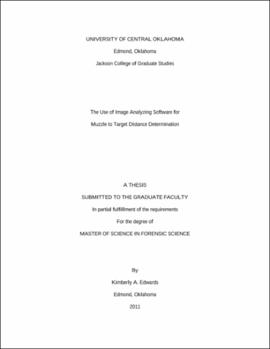| dc.description.abstract | Muzzle to target distance can be an important aspect in criminal investigations. For most distance determination opinions to be of value to an investigation, the range must be stated such that it gives meaningful information and the resulting bracket of muzzle to target distance must also be defended during courtroom testimony. Current measurement tools lead to subjective opinions by examiners. With objective measurements, examiners can provide improved investigative conclusions that may be defended in court with quantifiable data. Due to the rapid advancement in software technology in recent years, the ability exists to analyze targets with more accurate measurements. Currently, test targets are measured by approximate methods which utilize a high degree of subjectivity. This study examined the application of Image J, image analyzing software, for use in determining muzzle to target distance. This research examined objective data to include particulate density and Gunshot residue dispersion and carried out a statistical replicate study to determine the number of targets needed at a given distance for each gun and ammunition combination. One pistol, revolver, rifle and shotgun were selected for this study. Test targets were shot five times at distances of: 4, 8, 12, 16, 20, 24 and 28 inches for the pistol, revolver and rifle, and at distances of: 4, 8, 12 and 16 feet for the shotgun. Visual and chemical examinations were performed on test targets using standard protocol procedures, published through the National Institute of Justice (NIJ) Distance Determination Training Module (2011). The targets were digitally photographed through each step and analyzed using the aforementioned protocol and Image J, image analyzing software. Comparisons were made between the National Institute of Justice model and Image J. Data were obtained and reported using the image analyzing software for particulate count and GSR dispersion. | |
